
Glasgow is the most populous city in Scotland and the fourth-most populous city in the United Kingdom, as well as being the 27th largest city by population in Europe. In 2019, it had an estimated population of 633,120. Historically part of Lanarkshire, the city now forms the Glasgow City council area, one of the 32 council areas of Scotland; the local authority is Glasgow City Council. Glasgow is situated on the River Clyde in the country's West Central Lowlands. It is the fifth-most visited city in the United Kingdom.
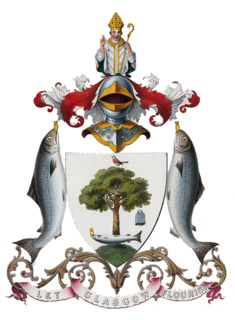
Kentigern, known as Mungo, was a missionary in the Brittonic Kingdom of Strathclyde in the late sixth century, and the founder and patron saint of the city of Glasgow.

George Square is the principal civic square in the city of Glasgow, Scotland. It is one of six squares in the city centre, the others being Cathedral Square, St Andrew's Square, St Enoch Square, Royal Exchange Square, and Blythswood Square on Blythswood Hill.

Glasgow Cathedral, also called the High Kirk of Glasgow, St Kentigern's or St Mungo's Cathedral, is the oldest cathedral in mainland Scotland and is the oldest building in Glasgow. The cathedral was the seat of the Archbishop of Glasgow until the Scottish Reformation, and it's congregation is today part of the Church of Scotland's Presbytery of Glasgow. Glasgow Cathedral is Crown property, and is the responsibility of Historic Environment Scotland.

The Metropolitan Cathedral Church of Saint Andrew or Glasgow Metropolitan Cathedral is a Roman Catholic Cathedral in the city centre of Glasgow, Scotland. It is the mother church of the Roman Catholic Archdiocese of Glasgow. The Cathedral, which was designed in 1814 by James Gillespie Graham in the Neo Gothic style, lies on the north bank of the River Clyde in Clyde Street. St Andrew's Cathedral is the seat of the Archbishop of Glasgow, currently sede vacante. It is dedicated to the patron saint of Scotland, Saint Andrew.

Townhead is an area of the city of Glasgow, Scotland. It is situated immediately north-east of Glasgow city centre and contains a residential sector, a commercial/industrial sector and the campus of the University of Strathclyde.
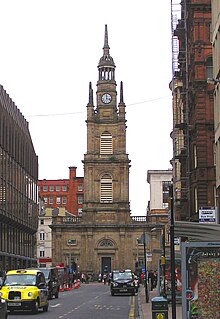
The St George's Tron Church, in Glasgow, Scotland, is a Church of Scotland church in the city centre, located in Nelson Mandela Place, previously known as St George's Place, fronting Buchanan Street at West George Street, along from Queen Street Station. It should not be confused with the 17th-century Tron Church, which lies to the south-west on Trongate and was redeveloped in the 1980s as the Tron Theatre. Located right on the busiest shopping street in Scotland, the building is a significant presence, and the oldest in the area. It stands as a terminating vista for West George Street.

Barclay Viewforth Church is a parish church of the Church of Scotland in the Presbytery of Edinburgh.
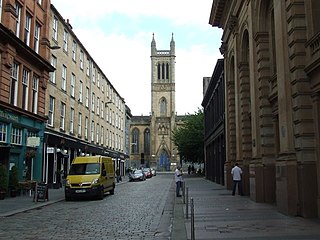
Candleriggs is a street in the city of Glasgow, Scotland. It is located in the Merchant City area of the city centre.

Trongate is one of the oldest streets in the city of Glasgow, Scotland. Trongate begins at Glasgow Cross, where the Tolbooth Steeple is situated, being the original centre of medieval Glasgow, and goes westward changing its name to Argyle Street at Glassford Street.
The Tobacco Lords were a group of Scottish merchants and slave traders who in the 18th century made enormous fortunes by trading in tobacco. Many became so wealthy that they adopted the lifestyle of aristocrats, lavishing vast sums on great houses and splendid churches.

Glasgow Cross is at the hub of the ancient royal burgh and now city of Glasgow, Scotland, close to its first crossing over the River Clyde. As a major junction in the city centre, its five streets run: north up the High Street to Glasgow Cathedral, Cathedral Square and the Royal Infirmary; east along Gallowgate and London Road, close to St Andrew's Square; south on the Saltmarket to Glasgow Green and the High Court; and its own Trongate continuing west as Argyle Street towards St Enoch Square and Buchanan Street.

Cathedral Square is a public square in the city of Glasgow, Scotland. Cathedral Square and precinct is situated adjacent to Glasgow Cathedral on High Street/Castle Street at John Knox Street. Nearby are many famous Glasgow Landmarks such as Provand's Lordship, Glasgow Royal Infirmary, Necropolis, the ceremonial Barony Hall of Strathclyde University, and the Glasgow Evangelical Church at the Square. It is one of six public squares and precincts in the city centre.
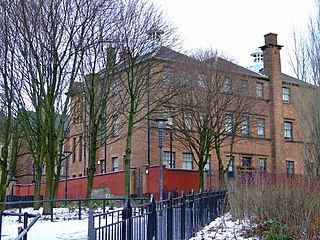
The Martyrs’ Public School, in Parson Street in the Townhead area of Glasgow, Scotland, is one of the earlier works of architect Charles Rennie Mackintosh. Until recently, an arts centre run by Glasgow Museums, it is now home to Glasgow City Council's Social Work Leaving Care Services. It is protected as a category A listed building. Stranded above the main road it was once set in the middle of a densely populated area of tenement buildings. It was built following the Education (Scotland) Act 1872 which provided for increased public expenditure on education. Commissioned by the School Board of Glasgow and built between 1895 and 1898, the architects were Honeyman and Keppie.

The city of Glasgow, Scotland is particularly noted for its 19th-century Victorian architecture, and the early-20th-century "Glasgow Style", as developed by Charles Rennie Mackintosh.
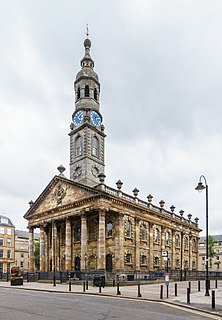
St Andrew's in the Square is an 18th-century category-A-listed former church in Glasgow, Scotland, considered one of the finest classical churches in Scotland, and now Glasgow's Centre for Scottish Culture, promoting Scottish music, song and dance. The church is in St Andrew's Square, near Glasgow Cross and Glasgow Green, on the edge of the City's East End.
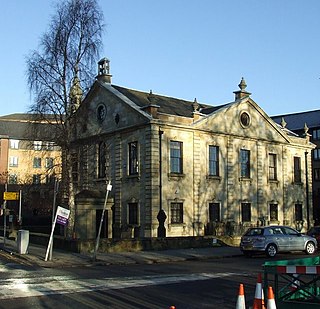
St Andrew's-by-the-Green is an 18th-century category-A-listed former church in Glasgow, Scotland, and the first Episcopal church built in the city. It is situated on the corner of Turnbull Street and Greendyke Street, overlooking Glasgow Green, on the edge of the city's East End.
Glasgow city centre is the central business district of Glasgow, Scotland. Is bounded by Saltmarket, High Street and Castle Street to the east, The River Clyde to the south and the M8 motorway to its west and north. Glasgow City Centre is composed of the areas of Garnethill, Blythswood Hill and Merchant City as well as parts of Cowcaddens, Townhead, Anderston and Calton.

The church is named after Saint Mungo, patron saint and founder of the city of Glasgow. It belongs to the Church of Scotland Presbytery of Stirling and serves the parish of Alloa. A chapel dedicated to St Mungo is thought to have been erected during the fourteenth or fifteenth-century, which became dependent upon the Parish of Tullibody. Alloa had grown into a parish in its own right by 1600 when the Act of Assembly united the two parishes. In 1680, the original chapel was rebuilt and enlarged. The current church replaces the old parish church from the seventeenth-century which had been deemed much too small for the congregation for over seventy years and was declared ruinous and unsafe in August 1815. The condition of the old church was so bad that services were often being held in the open air rather than risking injury to the congregation The decision was finally made to abandon the old building and find a site for a new parish church. The Erskine family donated land at Bedford Place and work on the new St Mungo's church began in 1817. The church congregation temporarily worshipped in the Tabernacle until the completion in 1819 of the new church. Since land was judged at the time to have too great a value to the living to be set aside for the dead, no graveyard was planned or added to the new church. The more elaborate scale and design of the new building was intended to reflect the increased size and prosperity of the nineteenth-century congregation. The church was one of the largest in Scotland at the time it was built.
Ralph Drummond was the first minister of a Presbyterian Church in South Australia


















